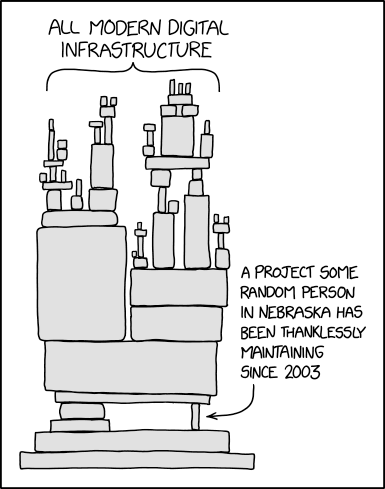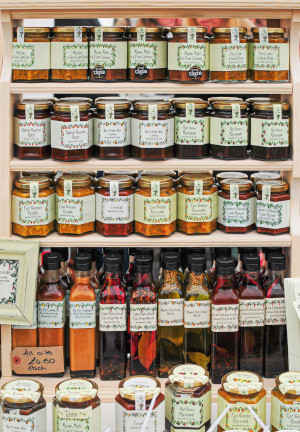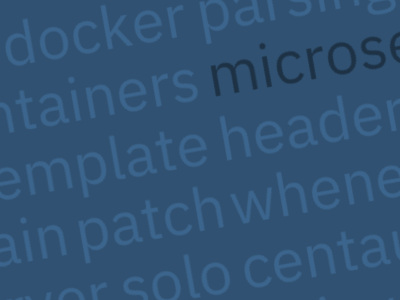Understanding Docker volume mounts
Published on

The Docker project logo
One thing that always confuses me with Docker is how exactly mounting volumes behaves. At a basic level it’s fairly straight forward: you declare a volume in a Dockerfile, and then either explicitly mount something there or docker automatically creates an anonymous volume for you. Done. But it turns out there’s quite a few edge cases…
Changing ownership of the folder
Perhaps the most common operation done on a Docker volume other than simply mounting it is trying to change the ownership of the directory. If your Docker process runs as a certain user you probably want the directory to be writable by that user.
At first we might try something like:
FROM alpine
RUN adduser -D -u 1113 test123
USER test123
VOLUME /testing
But changing the user doesn’t seem to have any effect on the volume.
Why? Checking the docs for the
USER instruction
shows that only affects certain future operations — namely
RUN, CMD, and ENTRYPOINT. It doesn’t affect the VOLUME instruction;
if it did, you’d probably just get a permission denied error unless the user
you switch to had privileges to create mount points.
OK, so instead we might try using the good old chown command:
FROM alpine
RUN adduser -D -u 1113 test123
VOLUME /testing
RUN chown test123 /testing
But again, the directory is just owned by root at runtime.
Back to the docs, this time for the
VOLUME instruction
and towards the bottom is this little tidbit:
Changing the volume from within the Dockerfile: If any build steps change the data within the volume after it has been declared, those changes will be discarded.
As soon as Docker hits the VOLUME instruction the directory becomes a mount
point, and anything we do to the temporary volume mounted there is discarded
during the build process. So we have to change the ownership before the
instruction, which may seem a little counter-intuitive:
FROM alpine
RUN adduser -D -u 1113 test123
RUN mkdir /testing && chown test123 /testing
VOLUME /testing
Now when the container runs, the /testing directory is owned by the test123 user. It’s not quite over, yet, though. This works if we let Docker create a volume automatically for us, or if we create a named volume and mount that; if we try and mount a host directory, though, it falls flat:
$ docker run --rm -it -v "$PWD/testing:/testing" testing ls -al /testing
total 8
drwxr-xr-x 2 1000 1000 4096 Apr 1 19:39 .
drwxr-xr-x 1 root root 4096 Apr 1 20:44 ..
Docker handles mounting host directories differently to mounting volumes, even though the syntax is basically the same. Host directories are bind mounted directly into the container, so the permissions and ownership are the same as the directory on your host. The only way to fix them are to either change the permissions on the host, or have the container change them at runtime (assuming it has sufficient privileges).
One final wrinkle in all this happens when you use the same volume in multiple containers. Here we have two images built from the Dockerfile above, one with userid 1113 and one with userid 1114:
$ docker volume create testing
testing
$ docker run --rm -it -v testing:/testing testing1113 ls -nal /testing
total 8
drwxr-xr-x 2 1113 0 4096 Apr 1 19:49 .
drwxr-xr-x 1 0 0 4096 Apr 1 20:51 ..
$ docker run --rm -it -v testing:/testing testing1114 ls -nal /testing
total 8
drwxr-xr-x 2 1114 0 4096 Apr 1 20:47 .
drwxr-xr-x 1 0 0 4096 Apr 1 20:52 ..
$ docker run --rm -it -v testing:/testing testing1114 touch /testing/Hello
$ docker run --rm -it -v testing:/testing testing1113 ls -nal /testing
total 8
drwxr-xr-x 2 1114 0 4096 Apr 1 20:52 .
drwxr-xr-x 1 0 0 4096 Apr 1 20:53 ..
-rw-r--r-- 1 0 0 0 Apr 1 20:52 Hello
$ docker run --rm -it -v testing:/testing testing1114 ls -nal /testing
total 8
drwxr-xr-x 2 1114 0 4096 Apr 1 20:52 .
drwxr-xr-x 1 0 0 4096 Apr 1 20:52 ..
-rw-r--r-- 1 0 0 0 Apr 1 20:52 Hello
Can you see what’s going on? When the volume is empty, the ownership changes based on the mount point in the container. Once it has something in it, the ownership is fixed.
So Docker behaves differently with regard to permissions:
- when the folder is mounted from the host vs a volume
- when the volume is empty vs having content
Pre-populating mounts with files from the image
One of the more esoteric features of the way Docker handles volume mounts is that in some cases files from the image are copied over into the container. For example:
$ docker volume create testing
testing
$ docker run --rm -it -v testing:/etc testing sleep 1
$ docker run --rm -it -v testing:/tmp testing ls -al /tmp
total 184
drwxr-xr-x 15 root root 4096 Apr 1 20:58 .
drwxr-xr-x 1 root root 4096 Apr 1 20:59 ..
-rw-r--r-- 1 root root 4 Jun 7 2018 TZ
-rw-r--r-- 1 root root 6 Dec 20 21:31 alpine-release
...
The first container we run mounts the newly created testing volume
at /etc. Docker copies all the existing files and folders into the
volume; when we then run the second container with the volume mounted
at /tmp, we can see all the files that were in the first container’s
/etc.
As with permissions, this behaviour is anything but consistent. Say we switch from a volume to a host directory:
$ mkdir testing
$ docker run --rm -it -v "$PWD/testing:/usr/bin" testing sleep 1
$ ls -al testing
total 8
drwxr-xr-x 2 root root 4096 Apr 1 22:05 .
drwxr-xr-x 3 chris chris 4096 Apr 1 22:05 ..
Nothing is copied in, and inside the container the folder will be empty. Based on our discoveries with permissions, it’s reasonable to assume the same will happen with a non-empty volume too:
$ docker volume create testing
testing
$ docker run --rm -it -v testing:/testing testing touch /testing/Hello
$ docker run --rm -it -v testing:/usr/bin testing sleep 1
$ docker run --rm -it -v testing:/tmp testing ls -al /tmp
total 8
drwxr-xr-x 2 root root 4096 Apr 1 21:09 .
drwxr-xr-x 1 root root 4096 Apr 1 21:09 ..
-rw-r--r-- 1 root root 0 Apr 1 21:08 Hello
So at least that’s consistent. If you’re very observant, though, you
might notice I switched from /etc/ to /usr/bin in the examples.
That’s because within the container /etc/ has some files bind-mounted
into it, such as /etc/resolv.conf, and these do always result in files
being created in the mounted volumes or folders:
$ mkdir testing
$ docker run --rm -it -v "$PWD/testing:/etc" testing sleep 1
$ ls -al testing
total 8
drwxr-xr-x 2 chris chris 4096 Apr 1 22:12 .
drwxr-xr-x 3 chris chris 4096 Apr 1 22:12 ..
-rwxr-xr-x 1 root root 0 Apr 1 22:12 hostname
-rwxr-xr-x 1 root root 0 Apr 1 22:12 hosts
-rwxr-xr-x 1 root root 0 Apr 1 22:12 resolv.conf
Summary
- Docker treats mounting host folders and mounting volumes differently. Don’t just assume that you can swap one for another and get the exact same behaviour.
- Empty volumes will inherit permissions and files from the image they are mounted in; non-empty volumes and host folders will not.
- Relying on Docker copying files into volumes is a very bad idea, as if you change those files in a future version of your image they will not be copied unless the volume is deleted and recreated.
I can’t find anywhere that these points are documented properly; if you know of anywhere, please drop me a message!
Thanks for reading!
Have thoughts? Send me an e-mail!
Related posts

Reproducible Builds and Docker Images
Reproducible builds are builds which you are able to reproduce byte-for-byte, given the same source input. Your initial reaction to that statement might be “Aren’t nearly all builds ‘reproducible builds’, then? If I give my compiler a source file it will always give me the same binary, won’t it?” It sounds simple, like it’s something that should just be fu...

Artisanal Docker images
I run a fair number of services as docker containers. Recently, I’ve been moving away from pre-built images pulled from Docker Hub in favour of those I’ve hand-crafted myself. If you’re thinking “that sounds like a lot of effort”, you’re right. It also comes with a number of advantages, though, and has been a fairly fun journey. The problems with Docker Hub and ...

Docker reverse proxying, redux
Six years ago, I described my system for configuring a reverse proxy for docker containers. It involved six containers including a key-value store and a webserver. Nothing in that system has persisted to this day. Don’t get me wrong – it worked – but there were a lot of rough edges and areas for improvement. Microservices and their limitations My goal was to follow the UNIX philo...
{% figure "left" "The Docker project logo" %} One thing that always confuses me with Docker is how exactly mounting volumes behaves. At a basic level it's fairly straight forward: you declare a v...